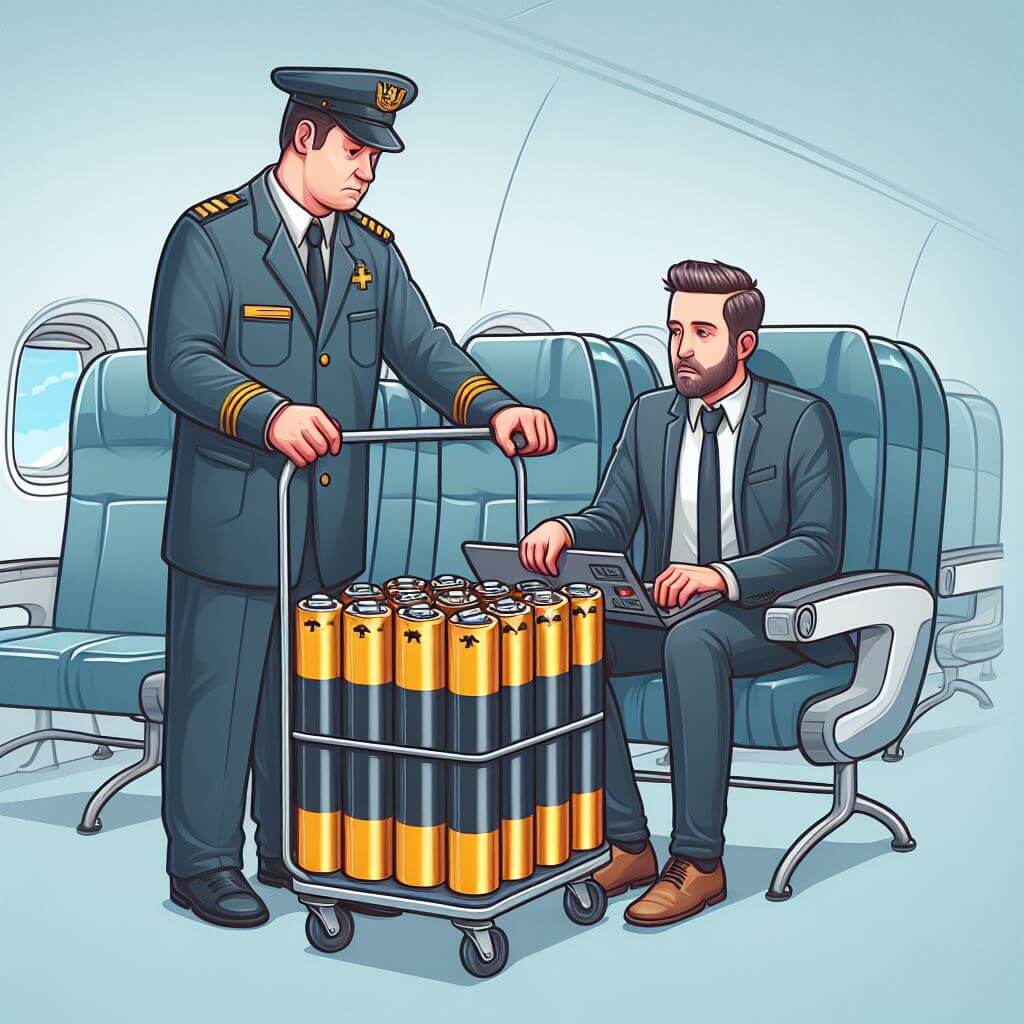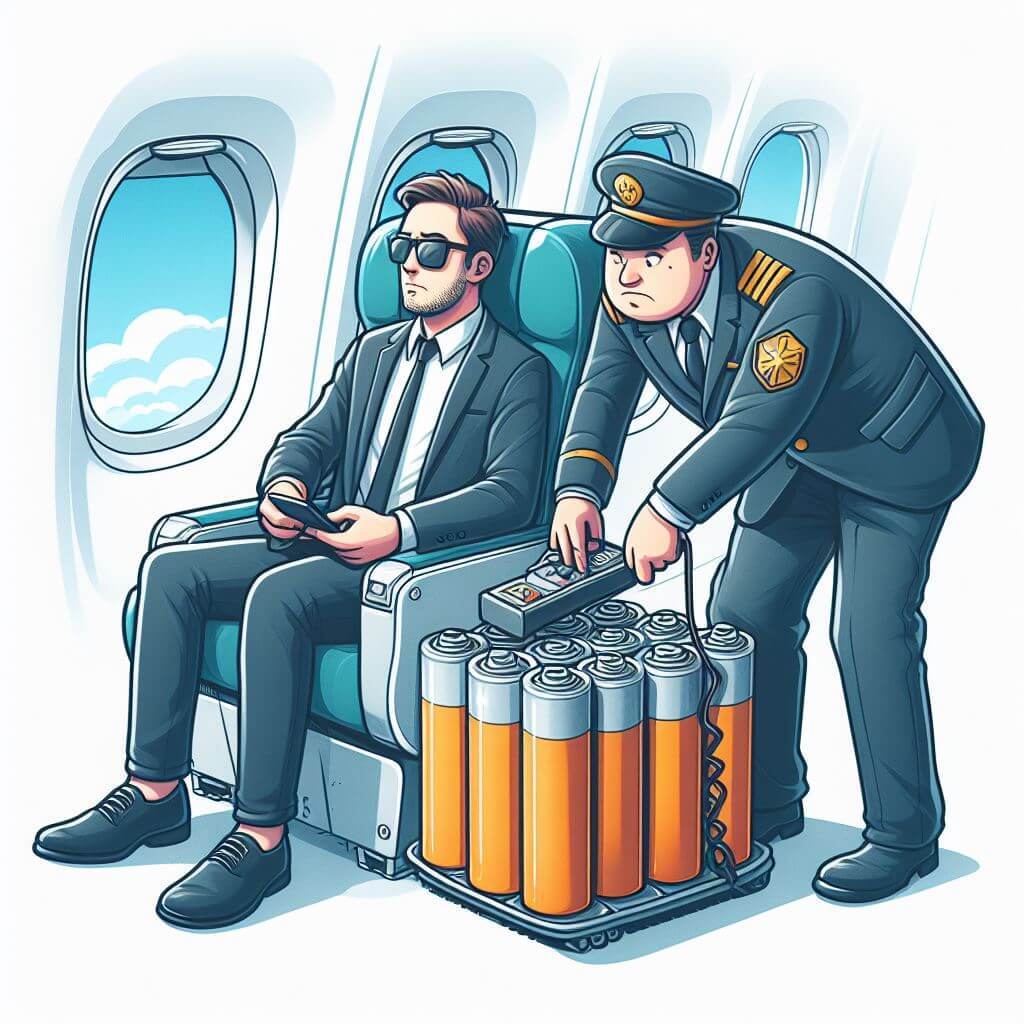Soaring High Without a Spark – Navigating Lithium Batteries on Your Next Flight
So you’ve booked your dream vacation, packed your bags, and are eagerly anticipating that exhilarating airplane takeoff. But hold on, adventurer! Before you soar through the clouds, there’s one crucial detail to consider: what lithium batteries are not allowed on airplanes.
That innocuous power bank powering your phone or the spare laptop battery tucked in your bag might seem harmless, but lithium batteries, while incredibly efficient, can pose safety risks at high altitudes. Understanding the regulations surrounding them is key to a smooth and safe journey.

In this blog, we’ll be your in-flight navigator, guiding you through the often-confusing world of lithium battery travel guidelines. We’ll decipher the rules, unpack the exceptions, and equip you with the knowledge to confidently pack your electronics without triggering any red flags at security.
Ready to ditch the travel anxiety and focus on exploring new horizons? Buckle up, and let’s dive into the fascinating world of lithium batteries and air travel!
Remember, knowledge is power, and when it comes to packing your tech gadgets, a little awareness can go a long way towards a hassle-free and unforgettable adventure. So, let’s explore the ins and outs of lithium batteries in the sky!
Powering Up with Knowledge – Demystifying Lithium Battery Regulations
We’ve established that not all lithium batteries are welcome aboard, but why is this the case? What makes these seemingly mundane energy sources raise eyebrows at security checkpoints?
The answer lies in their inherent power. Lithium batteries pack a remarkable punch, storing much more energy per unit weight than traditional ones. While this makes them ideal for powering our portable devices, it also presents a potential hazard in the confined space of an airplane.
Imagine this: a damaged or overheated lithium battery can potentially release heat and flammable gases, creating a fire risk in the pressurized cabin. This is why airlines stringently regulate the type and quantity of lithium batteries allowed on board.

Now, let’s break down the key terms in this equation:
- Lithium batteries: These are rechargeable or non-rechargeable batteries containing lithium metal or lithium ions. They power a wide range of electronics, from laptops and smartphones to cameras and headphones.
- Watt-hours (Wh): This unit measures the energy stored in a battery. For air travel, the crucial limit is 100 Wh. Batteries exceeding this threshold are generally considered high-risk and require special handling.
- Spare batteries: Batteries not installed in a device, such as power banks and extra laptop batteries, fall under this category. They have stricter regulations compared to batteries powering your gadgetry.
So, to simplify, lithium batteries with 100 Wh or less in a device are generally good to go, while spare (uninstalled) batteries, including power banks, face tighter restrictions. Remember, these are just the basics, and we’ll delve deeper into the specifics and exceptions in the next section.
Ready to unpack the intricacies of these regulations and confidently navigate the lithium battery landscape? Let’s embark it together!
Packing Smart – Unveiling the Lithium Battery Do’s and Don’ts for Air Travel
Now that we’ve demystified the terminology and grasped the importance of lithium battery safety, let’s chart a course through the practicalities of packing these powerhouses for your next flight. Remember, navigating these regulations doesn’t have to be a cryptic ordeal – knowledge is the key to smooth sailing through security.
Firstly, let’s address the golden rule: lithium batteries with 100 Wh or less, installed in your electronics, are generally welcome aboard in your carry-on luggage. This covers most laptops, smartphones, tablets, cameras, and headphones. Think “devices you use on a daily basis.” Pack them worry-free and enjoy your in-flight entertainment powered by their inherent juice.

However, for the power-hungry adventurers carrying high-wattage batteries(exceeding 100 Wh) or a stash of spare batteries, the rules get a bit more nuanced. Here’s where expert guidance comes in:
High-wattage Batteries (101-160 Wh):
- Limited quantity: You can pack up to two spare batteries between 101 and 160 Wh, but only after obtaining prior approval from your airline. Contact them well in advance to avoid last-minute hiccups.
- Protective packaging: Ensure these batteries are individually packed in strong, protective cases to prevent short circuits. Think sturdy containers or manufacturer-provided packaging.
- Clear labeling: Label each battery clearly with its Wh rating to facilitate smooth security checks. Remember, transparency is key!
Spare Batteries (Any Wh rating):
- Carry-on only: No matter the Wh rating, all spare batteries (power banks, phone charging cases, etc.) must be in your carry-on luggage. Checked baggage is a no-go zone for these independent power sources.
- Quantity restrictions: The number of allowed spare batteries varies depending on their Wh rating. Generally, you can carry up to two spare batteries below 100 Wh and one between 100 and 160 Wh. Check your airline’s specific guidelines for precise limitations.
- Damage checks: Inspect your spare batteries for any signs of damage, cracks, or leaks before packing. Damaged batteries are a safety hazard and will be confiscated at security.
Remember, these are just the general guidelines. Always double-check the regulations of your specific airline and destination country. Websites like the Transportation Security Administration (TSA) and Federal Aviation Administration (FAA) offer detailed information and downloadable charts to make packing a breeze.
By following these rules, you can ensure your lithium batteries travel safely and seamlessly, allowing you to focus on the exciting adventures that await!
Now, before we wrap up, let’s address some frequently asked questions and ensure you’re equipped with all the knowledge needed for a confident and informed air travel experience. Let’s move on to the “Conclusion & FAQs” section, shall we?
Conclusion & FAQs: Bon Voyage with Safe Batteries!
We’ve explored the fascinating world of lithium batteries and air travel, navigating the regulations and equipping you with the power of knowledge. Now, let’s tie up any loose ends and ensure you take flight with confidence:
Conclusion:
Traveling with lithium batteries shouldn’t be a daunting experience. By understanding the “why” behind the rules and implementing the “how” of safe packing, you can ensure a smooth and hassle-free journey. Remember, prioritizing safety and following airline regulations is key to a happy and responsible travel experience.
Embrace the joy of exploration without the burden of battery stress. Pack smart, stay informed, and let your adventures take flight, powered by well-managed lithium batteries.
FAQs:
Q: Can I bring my vape device on board?
A: Generally, no. Most airlines prohibit vaping devices due to their lithium batteries and potential fire risk. Check your airline’s specific policy for clarification.
Q: What happens if I accidentally bring a prohibited battery?
A: If your lithium batteries exceed the allowed limits or are not packed according to regulations, they may be confiscated at security. In some cases, you may face fines or delays.
Q: Where can I find more information about lithium battery regulations?
A: Excellent resources include the websites of the Transportation Security Administration (TSA) and the Federal Aviation Administration (FAA). They offer detailed guidelines, downloadable charts, and FAQs to keep you informed.
Bonus Tip:
Pack your power bank with a lower charge (ideally below 70%) to avoid raising any red flags at security.
Remember, a safe and informed traveler is a happy traveler. So, put your battery knowledge to the test, pack wisely, and embark on your next adventure with the confidence of a seasoned pro!
I hope this comprehensive conclusion and informative FAQs section provide your readers with a satisfying closure and valuable resources for their air travel journey. Please let me know if you have any other questions or require further assistance with your blog.
Bon voyage and happy travels!
Leave a Reply